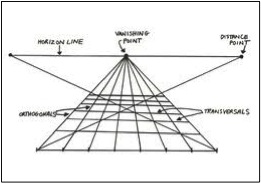
Perspective systems are designed to construct pictures that, when viewed, produce in the trained viewer the experience of depicted objects that match perceivable objects. Space perception theorists have written about how our capacities to see are constrained by the perspective system that we use, that is, by our way of depicting what we see.
 In the arts, the methods of depiction are of significant importance as they are the means of expression and description of imaginary worlds. Artists and designers engage in story telling and offer a glimpse into their fantasy worlds through unique, personal, private, and idiosyncratic visual methods. In the arts, the methods of depiction are of significant importance as they are the means of expression and description of imaginary worlds. Artists and designers engage in story telling and offer a glimpse into their fantasy worlds through unique, personal, private, and idiosyncratic visual methods.
Pictorial spaces are constructed through geometrical models. Each model is expressed as a geometrical transformation applied to Cartesian shapes of the physical environment. These transformations show how shapes are projected in pictorial space.
The usual projections we are accustomed to see in computer graphic are called standard projections: perspective and orthographic (Figure 1). However, there are many other projections we don’t ordinarily see called non-linear projections :bulge (Figure 2), fisheye (Figure 3), panoramas, map projections, etc.
Figure 1, Filippo Brunelleschi, Linear Perspective. Drawing by Silvia Minguzzi, 2013.
Figure 2 and 3, examples of non-linear perspective: bulge and fisheye projection. Photo by Silvia Minguzzi, 2013.
1 Terzidis and Malkawi, 2011, 262.
|

